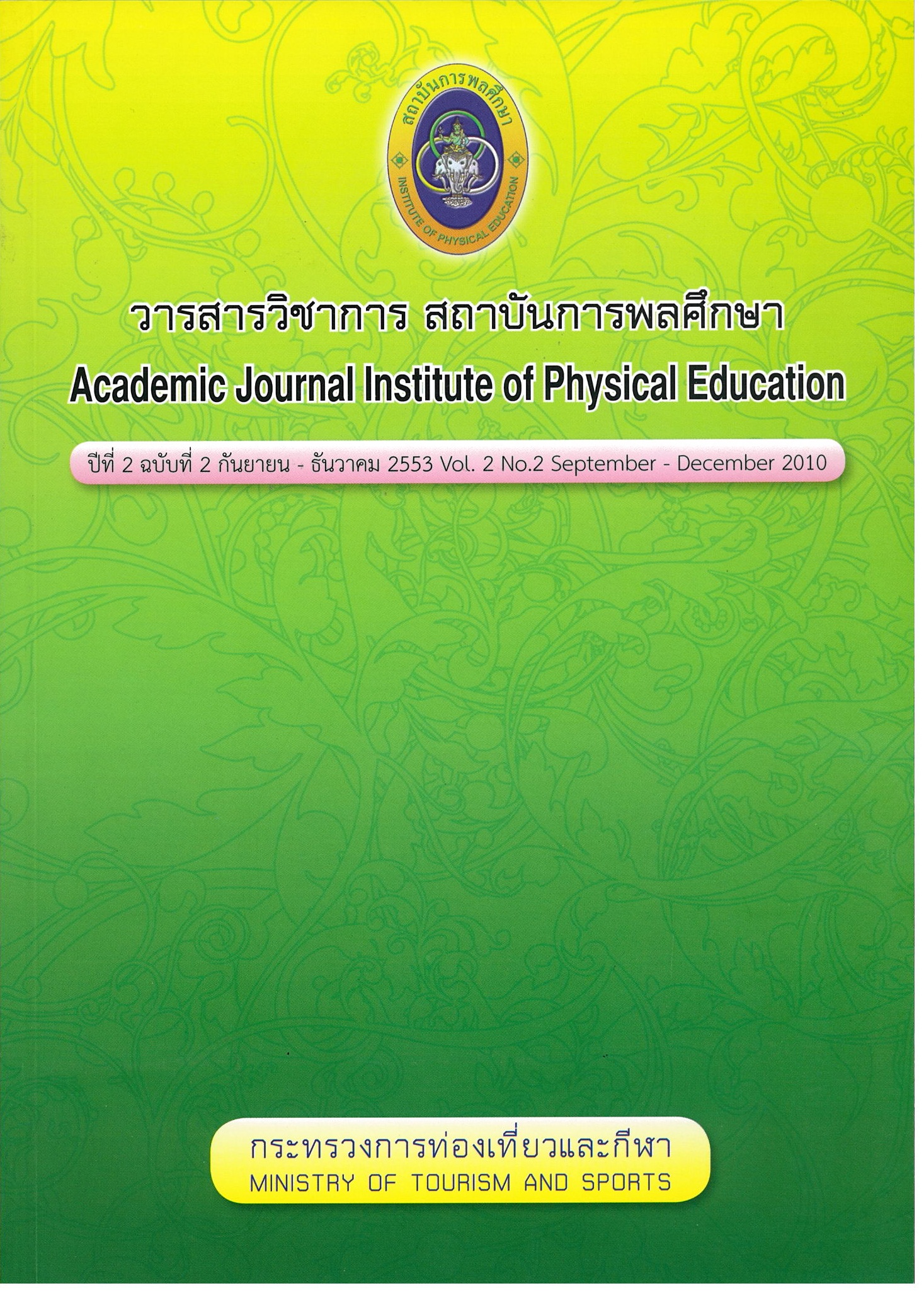ความต้องการของนักเรียนชั้นมัธยมศึกษาปีที่ 6 ในการเข้าศึกษาต่อ ในสถาบันการพลศึกษาสังกัดกระทรวงการท่องเที่ยวและกีฬา
Main Article Content
Abstract
This study was intended to investigate the needs to study in the Institutes of Physical Education of Matayomsueksa students in order to find ways to plan for recruiting the students to study in the Institutes. The subjects were 1,587 students randomly sampled from schools under the office of Fundamental Education, Ministry of Education. The collecting tools were the writer's constructed questionnaires. The data were statistically treated for mean, standard deviation. The mean differences were compared by One-way Analysis of Variance. The results were presented descriptively.
The data were collected from 1,587 subjects, but with 1,296 returned, 81.67%. It was found that 123 students wanted to study in the Institutes of Physical Education, 9.50%. The majority expressed that they could get a job after graduation from the Institutes, 16.90% and 16.60% found that there were possibilities to find jobs. It was found that 16.60% were
sure to graduate. There were 1,173, 90.51% students who were not interested in studying
in the Institutes of Physical Education.
The majority of 23.10% expressed that they wanted to study in the government universities; secondly, 17.10% of them wanted to go to open universities and 12.30% wanted to go to private universities.
It was found that the favorable factors to choose the Institutes of Physical Education
were as follows:
- Personal factors:
Most of the interested students were male, 52.00%. It was founded that most of them, 46.30%, wanted to study science and mathematics. Most of them had grade point averages between 2.01-2.55, 34.10%.
- Economy factors:
Most of the interested students lived with their parents with their average annual incomes less than 120,000 baht, 55,10%. They hoped to earn 8,001-10,000 baht monthly after graduation, 45.50%.
- Social factors:
Most of the interested students were natives of the central region, but they studied in the northeastern region, 39.00%. After graduation, they wanted to become government /government enterprise employees, 44,70%.
As a whole, the students found that the Institutes of Physical Education could improve the student's personality, at a high level. Secondly, they found that the Institutes could develop youths of quality. Lastly, the students found at the lowest level that there were few job opportunities after graduation from the Institutes.
This study was intended to investigate Matayomsueksa 6 student's needs to student in the Institutes of Physical Education. The subjects of 1,587 students were randomly sampled and tested for opinions by the questionnaire.
The data were statistically treated for mean, standard deviation and mean differences.
It was found that 9.50% of the students were interested in studying in the Institutes with 16.90% hoping to get a job and 16.60% to graduate.
There were 90.51% of the student who were not interested in studying in the Institutes, but they wanted to go to state or private universities.
The factors of interest were as follows:
- Personal factors were sexes as boys should interests to study in the Institutes, 52.00%. Their grade point averages were between 2.01-2.55, 34.196.
- Economy factors, the parent's incomes below 120,000 baht/year, 56.10%, were the greatest factor. Social factors were 39.00% as most of them lived in the central region, but moved to study in the northeastern region.
The students found that the Institutes of Physical Education could improve personality and developed youths of quality. The students found at the lowest level that there were few job opportunities after graduation from the institutes.
Article Details
The published article is a copyright of the Academic Journal of Thailand National Sports University. The passage appeared in each article in this academic journal is a perspective of each author which is not related to the journal. Each author is required to be responsible for all components of his/her own article. If there are any mistakes, each author must be responsible for those mistakes on his/her own.
References
กาญจนา คุณารักษ์. (2527). หลักสูตรและการพัฒนา นครปฐม : มหาวิทยาลัยศิลปากร.
ใจทิพย์ เชื้อรัตนพงษ์. (2537). “แนวคิดและวิธีการพัฒนาหลักสูตรอย่างเป็นระบบ” สารพัฒนาหลักสูตร 13(116) : 25-29.
พลศึกษา, กรม. (2531), วิทยาลัยพลศึกษาในทศวรรษหน้า, กรุงเทพฯ : กรมพลศึกษา. (2541).- ระเบียบกรมพลศึกษา ว่าด้วยการบริหารวิทยาลัยพลศึกษา พ.ศ.2541. กรุงเทพฯ : กรมพลศึกษา
พวงรัตน์ ทวีรัตน์. (2540), วิธีการวิจัยทางพฤติกรรมศาสตร์, พิมพ์ครั้งที่ 4. กรุงเทพฯ : สํานักทดสอบทางการศึกษาและจิตวิทยา มหาวิทยาลัยศรีนครินทรวิโรฒ ล้วน สายยศ และอังคณา สายยศ. (2538) เทคนิคการวิจัยทางการศึกษา, กรุงเทพฯ : สุวีรียาสาส์น
สถาบันการพลศึกษา กระทรวงการท่องเที่ยวและกีฬา. (2548). หลักสูตรสถาบันการพลศึกษาระดับ ปริญญาตรี พุทธศักราช 2548. กรุงเทพฯ : โรงพิมพ์องค์การรับส่งสินค้า และพัสดุภัณฑ์ (ร.ส.พ.)
สมพร พรหมจรรย์. (2540), องค์ประกอบที่เป็นแรงจูงใจในการศึกษาต่อ สายวิชาบริหารธุรกิจของนักศึกษา ระดับประกาศนียบัตรวิชาชีพชั้นสูง (ปวส.) สถาบันเทคโนโลยีราชมงคล ในเขต กรุงเทพมหานคร, ปริญญานิพนธ์ กศ.ม. (ธุรกิจศึกษา) กรุงเทพฯ : บัณฑิตวิทยาลัยมหาวิทยาลัยศรีนครินทรวิโรฒ. ถ่ายเอกสาร.
สํานักงานเขตพื้นที่การศึกษา กระทรวงศึกษาธิการ (2544). หลักสูตรการศึกษาขั้นพื้นฐาน พุทธศักราช 2544. กรุงเทพฯ : โรงพิมพ์คุรุสภา.
สํานักงานคณะกรรมการการศึกษาแห่งชาติ. (2543). สํานักนายกรัฐมนตรี รายงานผลการประชุม สมัชชาการศึกษาท้องถิ่นเพื่อการปฏิรูปการเรียนรู้, กรุงเทพฯ : ม.ป.พ.
อารีย์ พันธมณี. (2534). จิตวิทยาการเรียนการสอน. กรุงเทพฯ : บริษัทเลิฟแอนด์สิฟเพรส จํากัด.
อัจฉรา วงศ์วัฒนามงคล(2533). ตัวแปรทางพฤติกรรมศาสตร์ที่เกี่ยวข้องกับการศึกษาต่อในระดับบัณฑิตศึกษา ปริญญานิพนธ์ วท.ม. (การวิจัยพฤติกรรมศาสตร์ประยุกต์) กรุงเทพฯ : บัณฑิตวิทยาลัย มหาวิทยาลัยศรีนครินทรวิโรฒ ถ่ายเอกสาร.

